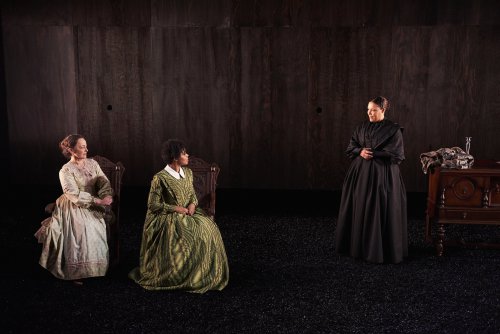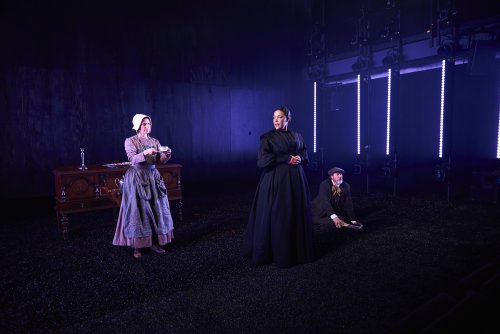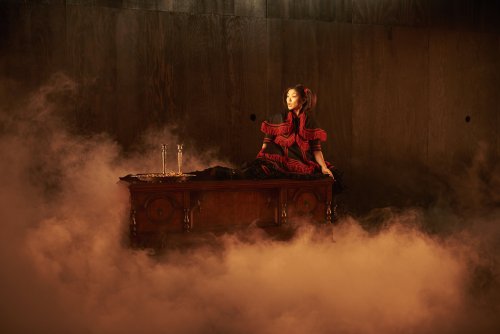The Moors
Attempt at a parody of the Bronte Sisters and the 19th century Gothic novel is more Theater of the Absurd than the Romantic Era and far too contemporary.
 [avatar user=”Victor Gluck” size=”96″ align=”left” ] Victor Gluck, Editor-in-Chief[/avatar]A successful parody should do three things: satirize deeply, entertain widely, and make a statement about the topic up for discussion. This Jen Silverman’s The Moors fails to do. The title The Moors suggests the Bronte sisters, Anne, Charlotte and Emily, those reclusive geniuses who grew up in a 19th century parsonage in Yorkshire, England, and, though with limited life experience, wrote some of the greatest Gothic novels of all time. The play specifically satirizes Charlotte’s Jane Eyre and Emily’s Wuthering Heights, rearranging bits and pieces of both books, among others.
[avatar user=”Victor Gluck” size=”96″ align=”left” ] Victor Gluck, Editor-in-Chief[/avatar]A successful parody should do three things: satirize deeply, entertain widely, and make a statement about the topic up for discussion. This Jen Silverman’s The Moors fails to do. The title The Moors suggests the Bronte sisters, Anne, Charlotte and Emily, those reclusive geniuses who grew up in a 19th century parsonage in Yorkshire, England, and, though with limited life experience, wrote some of the greatest Gothic novels of all time. The play specifically satirizes Charlotte’s Jane Eyre and Emily’s Wuthering Heights, rearranging bits and pieces of both books, among others.
Although the play demonstrates a surface knowledge of the genre and the period, it wants to have it both ways: it takes place in 1840 in a desolate mansion on the Yorkshire Moors but the characters talk and behave as though it is the present. It appears to be making a feminist statement by making all the members of the household female but has nothing new to say on the subject other than as a variation on these famous novels. And it attempts to be funny but isn’t clever or surprising enough to trigger much laughter.
Directed by Mike Donahue, the play is more Theater of the Absurd (think Beckett and Ionesco) than the Romantic Era or the Gothic horror story. With a minimalist setting by Dane Laffrey which uses no more than two carved chairs and a sideboard to suggest all the furnishings of an elegant old mansion throughout the evening, the play is devoid of atmosphere aside from a great deal of smoke which accompanies the outdoor scenes. Apparently, in the Yale Repertory Theatre world premiere, the scenery was elaborately Victorian and redolent of the era. Here even the smoke clears before the scenes on the moors begin. Some of the gimmicks are tried so often they just become tedious, like every room in the house described as looking like the parlor – or actually being the same room.
Since their minister father died, sisters Agatha and Huldy live alone in an ancient mansion on the English moors. Agatha, the older sister, runs the household and dominates her younger, more childish sister. They had a profligate brother Bramwell (as did the Brontes) but he is either dead or gone. They are served by one servant who is Marjory when she is the scullery maid, with a cough suggesting typhus, and she is Mallery when she is the parlor maid, with child. While this device could be hilarious, here it fails to be effective.

Hannah Cabell, Linda Powell and Andrew Garman in a scene from “The Moors” (photo credit: Joe Crea)
Huldy’s one activity is writing in her diary – though she has no adventures or incidents to relate. Emilie, a professional governess, arrives to take care of a child (just like Jane Eyre) – only to find there is no child and that the letters she received are not from Bramwell but Agatha. She is told that Bramwell is dead – or in the attic. The maid convinces Huldy to murder her sister in order to become a famous writer, while Agatha and Emilie are strongly attracted to each other. Events spiral out of control ending in a new order in the mansion on the moor.
Too many of the events and characters appear to be taken from works by the Brontes without doing anything with them. Like Jane Eyre’s Bertha Mason, someone is said to be in chains in the attic. Given the name of the author of Wuthering Heights, Emilie (spelled the French way) is a governess like Jane Eyre coming to a desolate house. Like Jane, Emilie spars with her employer and they find they have much in common. Like the Bronte sisters, several of the residents here try their hand at writing and hope to become famous. All of this may be in homage to the women of Haworth Parsonage but the satire is extremely mild. The only new wrinkle is the out-of-character 20th century behavior which is neither motivated nor believable.
In between the scenes in the gloomy mansion are ones between the family’s “very large and very dangerous” dog, The Mastiff (played by Andrew Garman), and a Moor Hen (Teresa Avia Lim) that has crash landed nearby and is unable to fly away. They have existential conversations that seem to be out of a Beckett play though not much is learned from them except that the world we live in is a terrible place. While this might have been instructive as a story told by the inhabitants of the house, it is rather purposeless used this way. Making the only male character an animal may have been intended as a feminist idea but nothing is done with the concept except for Agatha to tell Emilie to avoid it.
While the script of The Moors required a multiethnic cast, the choice of this casting seems more pointless than meaningful. All the actors use American accents as though this is a send up of the British Gothic novel without it actually being a satire. When the women finally kiss, it seems more like an attempt to stand the 19th century novel on its head rather than an actual feminist statement. Say for Donahue’s direction it is all of a piece and maintains its style throughout, but where irony is required it falls short.

Teresa Avia Lin as the Moor-Hen in a scene from “The Moors” (photo credit: Joe Crea)
We never know if Birgit Huppuch’s Huldey is intended to be as simpleminded as she is playing her – or she ought to be much younger? – to explain her naiveté. Linda Powell’s Agatha is commanding and reticent without giving us a clue as to where she is coming from. Chasten Harmon gamely plays Emilie as one buffeted by fate but does not have a clear handle on her character. Hannah Cabell is amusing as the sinister servant with the split personality but isn’t given enough to say or do to make this a truly comic character. Lim and Garman try hard as the introspective animals but are never allowed to let us know how real or imaginary they are.
Laffrey’s setting is too abstract for a play which needs a great deal of atmosphere. That we have to look at the same set for the play’s 15 scenes becomes tedious. The costume design by Anita Yavich is extremely realistic for the human characters, stylized for the animals. Unfortunately, the style of the acting and directing does not warrant it. As the production uses the entire space at the Duke on 42nd Street there is a hollowness to the voices which may or may not be intentional in M. L. Dogg’s sound design. Jen Schriever’s lighting never suggests the darkness of the life the characters are leading but uses colored lights to periodically and distractingly change the setting, along with vertical bars of white lights on the sides of the stage, without adding to the drama or the mood. The use of smoke to represent the mists on the moors before each outdoor scene is ineffective as the actors wait until it has dissipated before beginning their scenes.
The reviews of the Yale production suggest that another mode of both direction and design might have made a difference. As it stands, The Playwrights Realm’s staging of The Moors is a failure that might have been avoided, though the play does not go as far as it ought in trying to be a satire of the 19th century novels as written by the great Victorian women authors. What the play does is make you want to read – or reread – the classic study of Victorian literature from a feminist point of view, The Madwoman in the Attic by Sandra Gilbert and Susan Gubar.
The Moors (through March 25, 2017)
The Playwrights Realm
The Duke on 42nd Street, 229 W. 42nd Street, in Manhattan
For tickets, call 646-223-3010 or visit http://www.dukeon42.org
Running time: one hour and 55 minutes with no intermission






Leave a comment